In the vibrant landscapes of Kansas, an astonishing array of hummingbird species grace the skies, numbering a remarkable 11.
With their iridescent plumage and extraordinary flight capabilities, these enchanting creatures bring a touch of magic to the Sunflower State.
From the iconic Ruby-throated to the dazzling Broad-billed and the elusive Rivoli’s, each species contributes to the rich avian tapestry of Kansas.
In this exploration, we will unravel the fascinating stories of these 11 hummingbird species, delving into their unique characteristics, migratory patterns, and vital roles in pollination.
Get ready to embark on a journey into the mesmerizing world of hummingbirds, where delicate beauty and extraordinary feats of nature converge in the heart of Kansas. Stay focused.
11 Hummingbirds In Kansas
Get into the enchanting world of hummingbirds, where vibrant colors, remarkable agility, and delicate beauty come together.
In this journey, we’ll delve into these captivating creatures’ lives, uncovering each species’ unique characteristics and lifestyles.
From the tiny Ruby-throated to the dazzling Rivoli’s, discover the fascinating diversity within the hummingbird family.
1. Ruby-throated Hummingbird
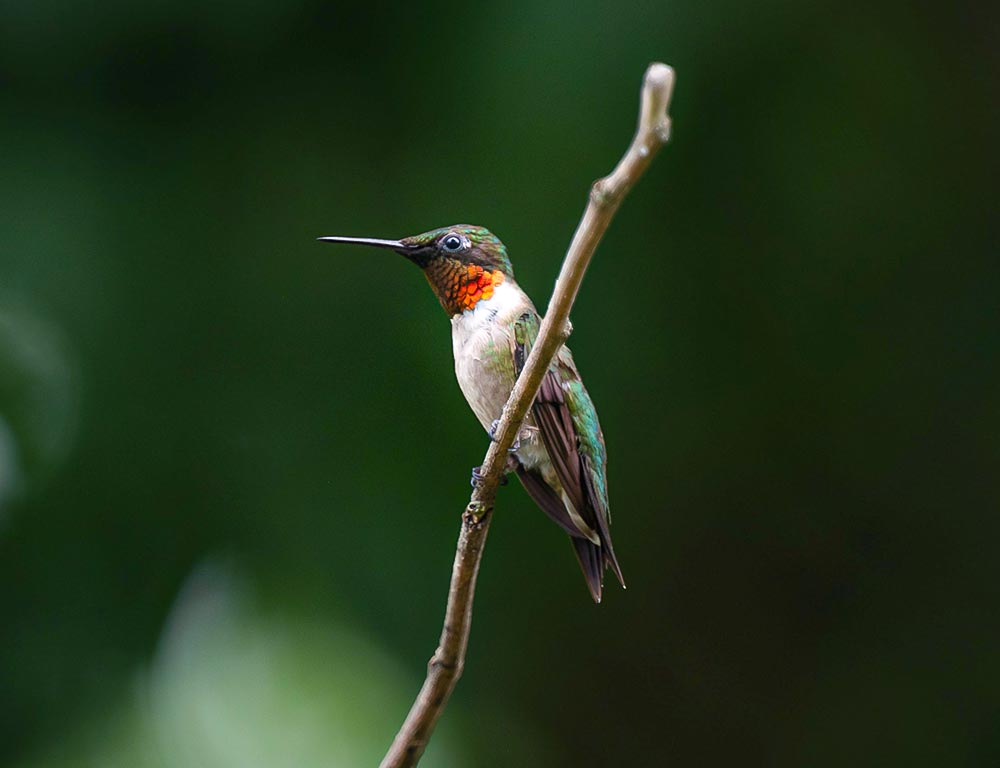
- Scientific name: Archilochus colubris
- Category: Small bird
- Population: Common in eastern North America, including Kansas
- Life span: 3 to 5 years
- Size: 3 to 3.5 inches
- Weight: 2 to 20 grams
- Food: Nectar, insects, spiders
- Wingspan: 3 to 4 inches
- Status: Least Concern (according to the IUCN Red List)
The Ruby-throated Hummingbird is the only species of hummingbird that breeds in eastern North America, and it is a common sight in Kansas during the summer months.
The males are particularly striking with vibrant emerald-green plumage and, as the name suggests, a brilliant ruby-red throat.
These tiny birds are known for their agility in flight, capable of hovering in mid-air and rapid movements, thanks to their incredible wingbeats.
Ruby-throated Hummingbirds feed primarily on nectar from various flowers, using their specialized bills and long, extendable, tube-like tongues.
Additionally, they consume small insects and spiders for essential proteins. These birds migrate long distances, with many spending winters in Central America or Mexico.
The females are responsible for building nests and raising the young. The nests are usually constructed on branches or in trees, camouflaged with lichens, and bound together with spider silk.
Ruby-throated Hummingbirds play a crucial role in pollination, contributing to the biodiversity of the ecosystems they inhabit.
2. Broad-tailed Hummingbird
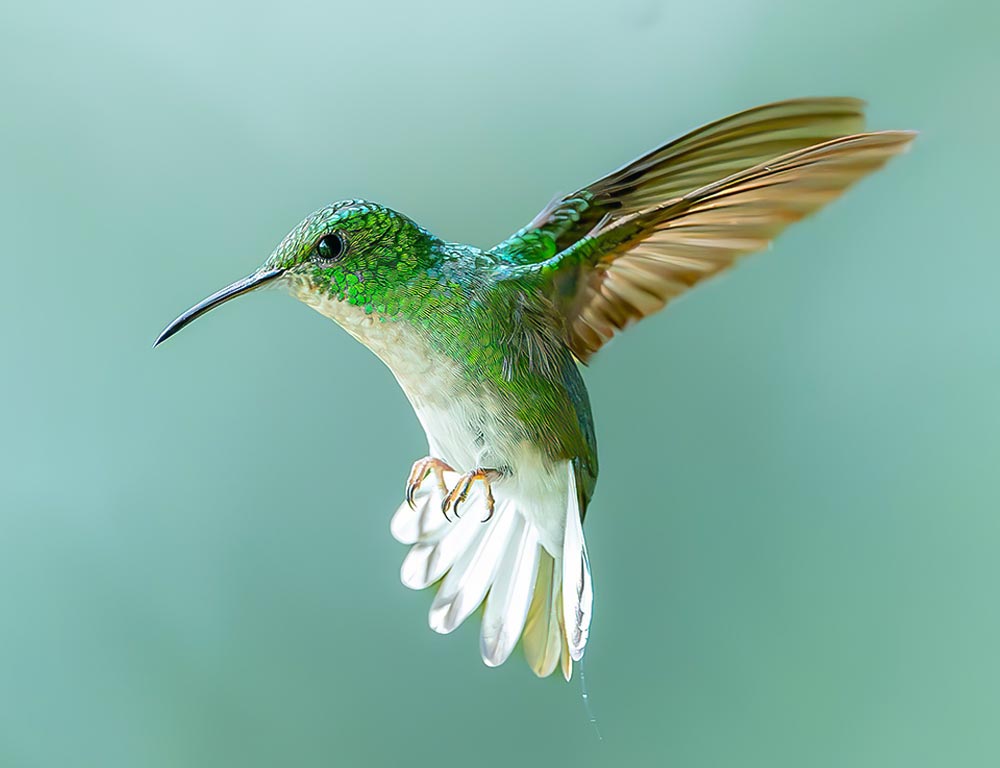
- Scientific name: Selasphorus platycercus
- Category: Small bird
- Population: Common in western North America, including Kansas
- Life span: 3 to 5 years
- Size: 4 to 4.3 inches
- Weight: 3 to 9 grams
- Food: Nectar, insects
- Wingspan: 8 inches
- Status: Least Concern (according to the IUCN Red List)
The Broad-tailed Hummingbird is a charming species found in western North America, including Kansas.
Identified by the males’ distinctive iridescent rose-colored throat and metallic green plumage, these birds are a delight to observe. Their wings produce a distinctive trilling sound during flight, adding to their allure.
These hummingbirds, like others, primarily feed on nectar from various flowering plants, and their diet is supplemented with small insects.
During the breeding season, males engage in aerial displays, creating a buzzing sound with their wings to attract females. The females build cup-shaped nests on branches using plant fibers, spider silk, and lichens.
Broad-tailed Hummingbirds are known for their migration patterns, covering significant distances between their breeding and wintering grounds. They contribute to pollination, making them vital components of the ecosystems they inhabit.
3. Rufous Hummingbird
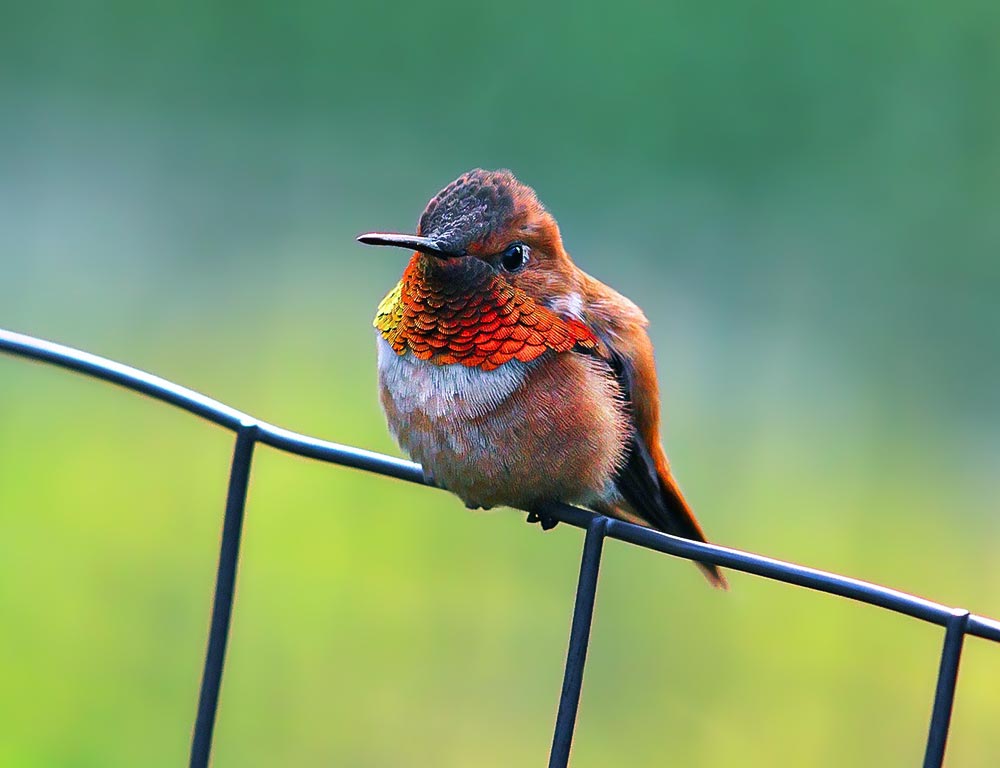
- Scientific name: Selasphorus rufus
- Category: Small bird
- Population: Common in western North America, including Kansas
- Life span: 3 to 5 years
- Size: 3.1 to 3.6 inches
- Weight: 2 to 5.5 grams
- Food: Nectar, insects
- Wingspan: 4.3 inches
- Status: Least Concern (according to the IUCN Red List)
The Rufous Hummingbird is a lively and territorial species that can be found in various habitats in western North America, including Kansas. Recognizable by their bright orange-red plumage and iridescent coppery-gold patches, male Rufous Hummingbirds are particularly distinctive.
These hummingbirds have a remarkable migratory journey, covering thousands of miles from their breeding grounds in the northern United States and Canada to their wintering areas in Mexico.
During their migration, they are known to be among the species that cover the longest migratory routes. Rufous Hummingbirds feed on nectar from various flowers, and they also catch insects in flight for additional protein.
The females construct nests in sheltered locations, often on branches or shrubs, using plant fibers, downy materials, and spider silk.
Despite their small size, Rufous Hummingbirds are known for their feisty nature, often engaging in territorial disputes with other hummingbirds.
Their presence adds vibrancy to the ecosystems they inhabit, and their role in pollination is crucial for the reproduction of many plant species.
4. Black-chinned Hummingbird
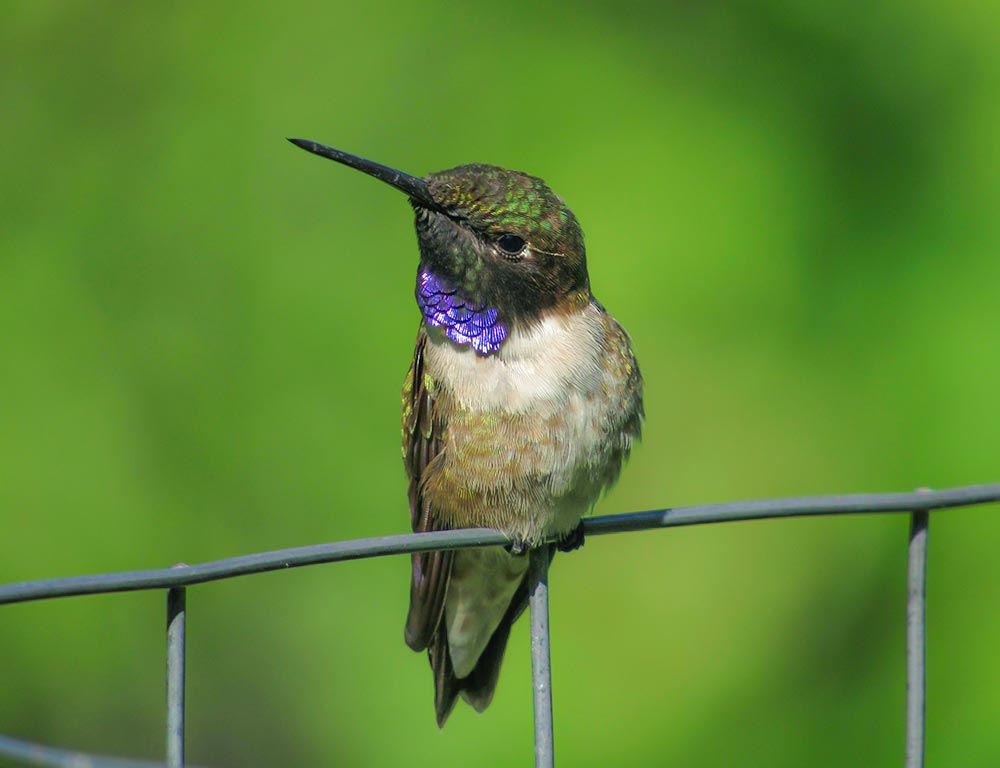
- Scientific name: Archilochus alexandri
- Category: Small bird
- Population: Widespread in western North America, including Kansas
- Life span: 3 to 5 years
- Size: 3.5 to 4 inches
- Weight: 2 to 5 grams
- Food: Nectar, insects
- Wingspan: 4.3 inches
- Status: Least Concern (according to the IUCN Red List)
The Black-chinned Hummingbird is a species commonly found in western North America, including Kansas, during the breeding season.
Identified by the male’s black chin and throat with a purple iridescence, these hummingbirds are known for their subtle yet elegant appearance.
Black-chinned Hummingbirds primarily feed on nectar from various flowers and supplement their diet with insects. Their slender bills and specialized tongues allow them to extract nectar efficiently.
During the breeding season, males perform aerial displays to attract females, showcasing their remarkable agility. Females are responsible for building cup-shaped nests on tree branches using plant fibers, spider silk, and downy materials.
The nests are well-camouflaged, often resembling small bumps on the branches. These hummingbirds play a crucial role in pollination as they move from flower to flower in search of nectar.
5. Costa’s Hummingbird
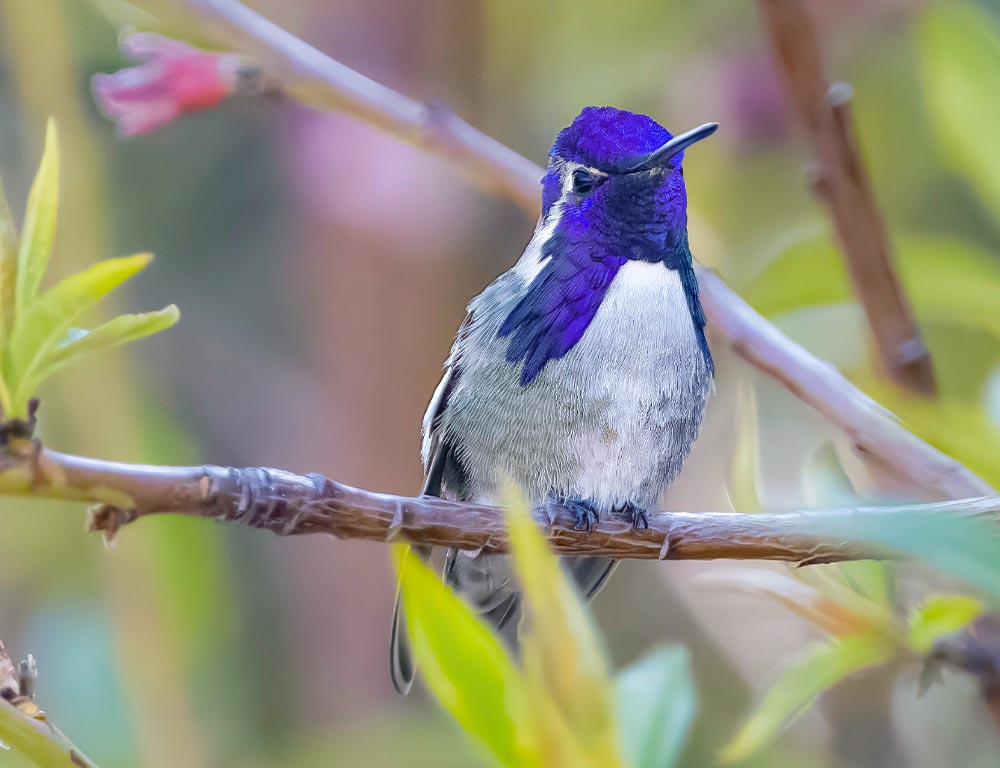
- Scientific name: Calypte costae
- Category: Small bird
- Population: Native to the southwestern United States and parts of Mexico, including Kansas
- Life span: 3 to 5 years
- Size: 3 to 3.5 inches
- Weight: 2 to 5 grams
- Food: Nectar, insects
- Wingspan: 4.3 inches
- Status: Least Concern (according to the IUCN Red List)
Costa’s Hummingbird is a species native to the arid regions of the southwestern United States and parts of Mexico, including areas of Kansas.
The male Costa’s Hummingbird is known for its vibrant purple crown and throat, creating a stunning contrast with its green body.
These hummingbirds primarily feed on nectar, often favoring desert flowers, and supplement their diet with insects for protein.
Costa’s Hummingbirds are adapted to arid environments, and their ability to survive in such conditions makes them unique among hummingbird species.
During the breeding season, males use impressive aerial displays to attract females.
The females build cup-shaped nests using plant fibers and downy materials, often placing them on horizontal branches. Their nests are well-camouflaged to protect them from predators.
6. Anna’s Hummingbird
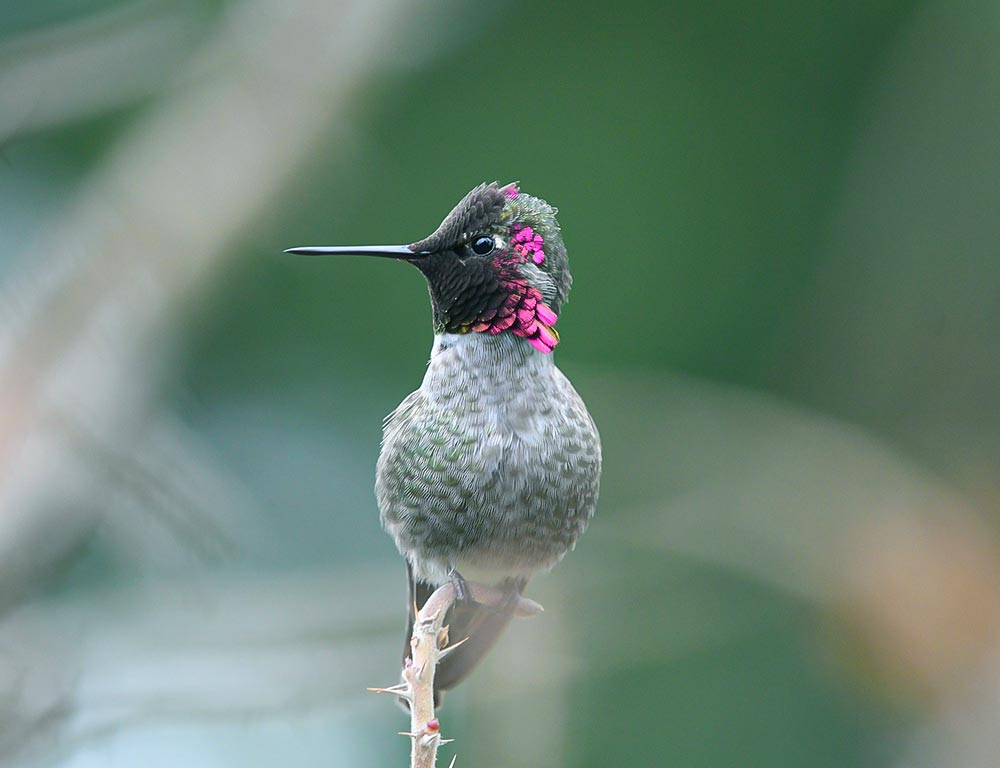
- Scientific name: Calypte anna
- Category: Medium-sized bird (larger for a hummingbird)
- Population: Resident along the western coast of North America, including parts of Kansas
- Life span: 4 to 5 years
- Size: 3.9 to 4.3 inches
- Weight: 3 to 6 grams
- Food: Nectar, insects
- Wingspan: 7.1 inches
- Status: Least Concern (according to the IUCN Red List)
Anna’s Hummingbird is a unique hummingbird species known for its iridescent pinkish-red crown and throat.
Unlike many other hummingbirds, Anna’s Hummingbird is a resident along the western coast of North America, including parts of Kansas, throughout the year.
These medium-sized hummingbirds feed on nectar from a variety of flowers and consume insects for additional nutrients. They are known for their adaptability and can be found in urban and suburban areas, making use of backyard feeders.
Anna’s Hummingbirds build cup-shaped nests using plant fibers, moss, and spider silk.
They often place their nests in sheltered locations, including trees and shrubs. The courtship displays of the males involve aerial acrobatics and rapid dives.
7. Calliope Hummingbird
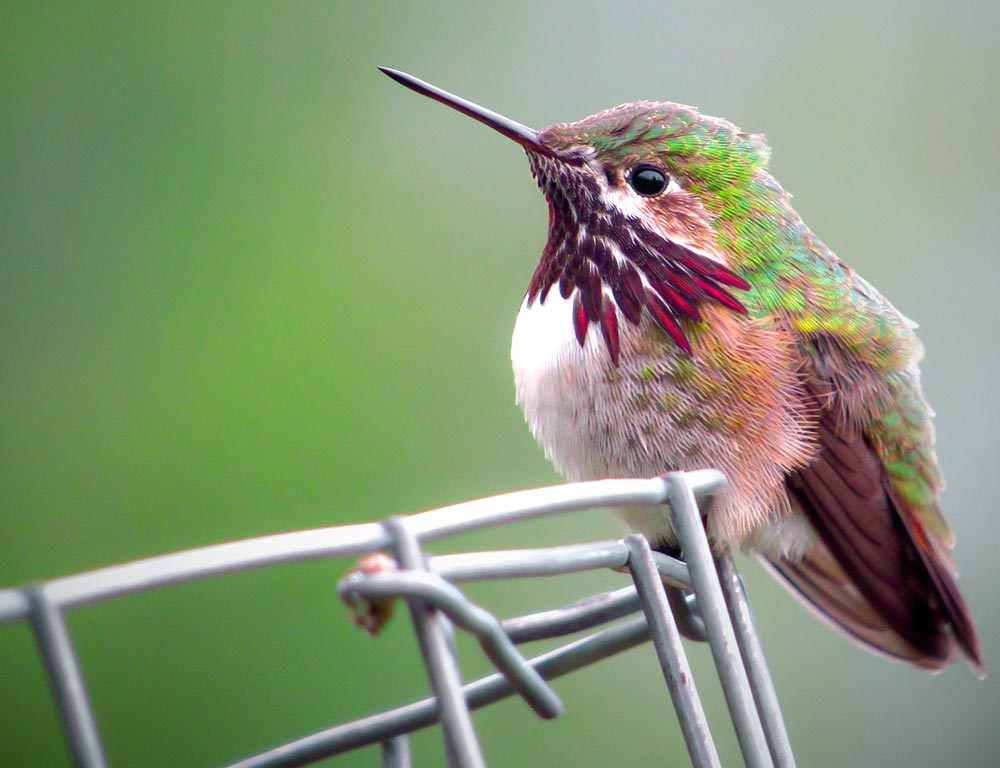
- Scientific name: Selasphorus calliope
- Category: Small bird
- Population: Breeds in western North America, including parts of Kansas
- Life span: 3 to 5 years
- Size: 2.8 to 3.5 inches
- Weight: 2 to 4 grams
- Food: Nectar, insects
- Wingspan: 4.1 inches
- Status: Least Concern (according to the IUCN Red List)
The Calliope Hummingbird is the smallest bird species in North America and is known for its vibrant coloring and intricate courtship displays.
Males have an iridescent magenta-red throat with green and white markings, while females have a more subdued greenish color.
Calliope Hummingbirds primarily feed on nectar from various flowers, utilizing their long, specialized bills.
They are also known to catch insects in mid-air for protein. During the breeding season, males perform elaborate aerial displays to attract females, involving rapid dives and buzzing sounds created by their wingbeats.
Females construct small, cup-shaped nests using plant fibers, lichens, and spider silk, often placing them on horizontal branches. Calliope Hummingbirds play a crucial role in pollination as they move from flower to flower, transferring pollen in the process.
8. Allen’s Hummingbird
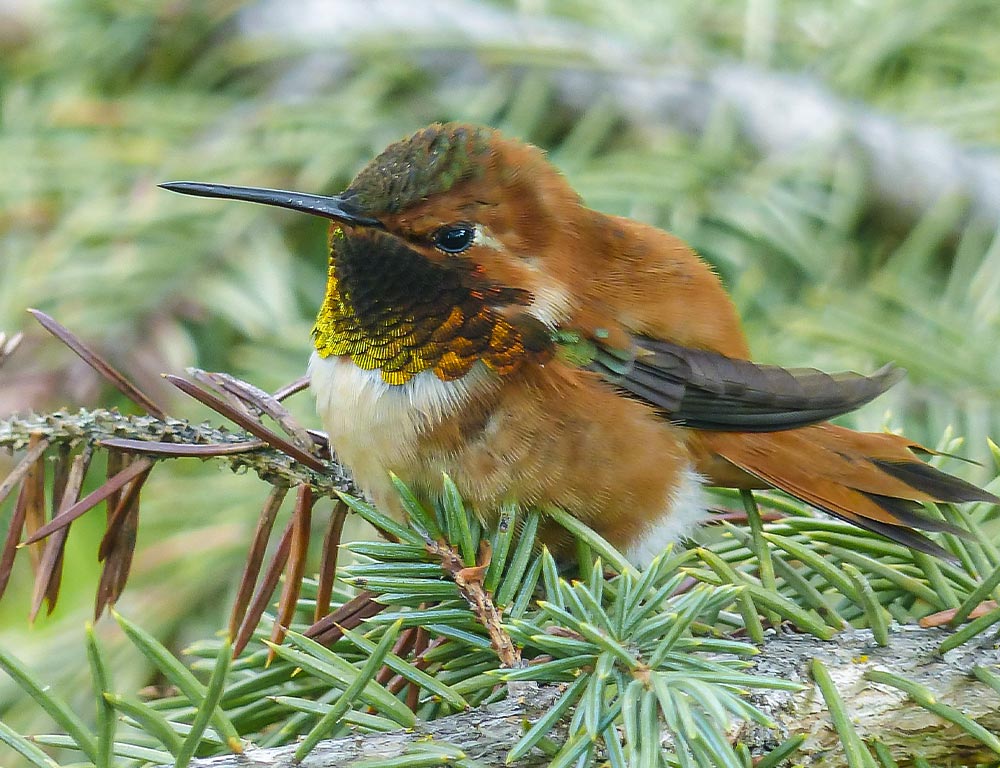
- Scientific name: Selasphorus sasin
- Category: Small bird
- Population: Resident along the western coast of North America, including parts of Kansas
- Life span: 3 to 5 years
- Size: 3.5 to 4 inches
- Weight: 2 to 5 grams
- Food: Nectar, insects
- Wingspan: 4.3 inches
- Status: Least Concern (according to the IUCN Red List)
Allen’s Hummingbird is a resident along the western coast of North America, including parts of Kansas. These hummingbirds are known for their striking iridescent coloring, with males exhibiting vibrant orange-red throats and green bodies.
Like other hummingbirds, Allen’s Hummingbirds primarily feed on nectar from various flowers and consume insects for essential proteins. They are adaptable and can often be found in gardens and urban areas, using artificial feeders.
During the breeding season, males engage in courtship displays, which involve hovering in front of females and making elaborate arcs in the air.
The females are responsible for building nests, which are often placed on horizontal branches and camouflaged with lichens and moss.
Allen’s Hummingbirds contribute to the ecological balance by aiding in pollination as they move from flower to flower. Their presence adds vibrant colors and dynamic energy to the landscapes they inhabit.
9. Rivoli’s Hummingbird
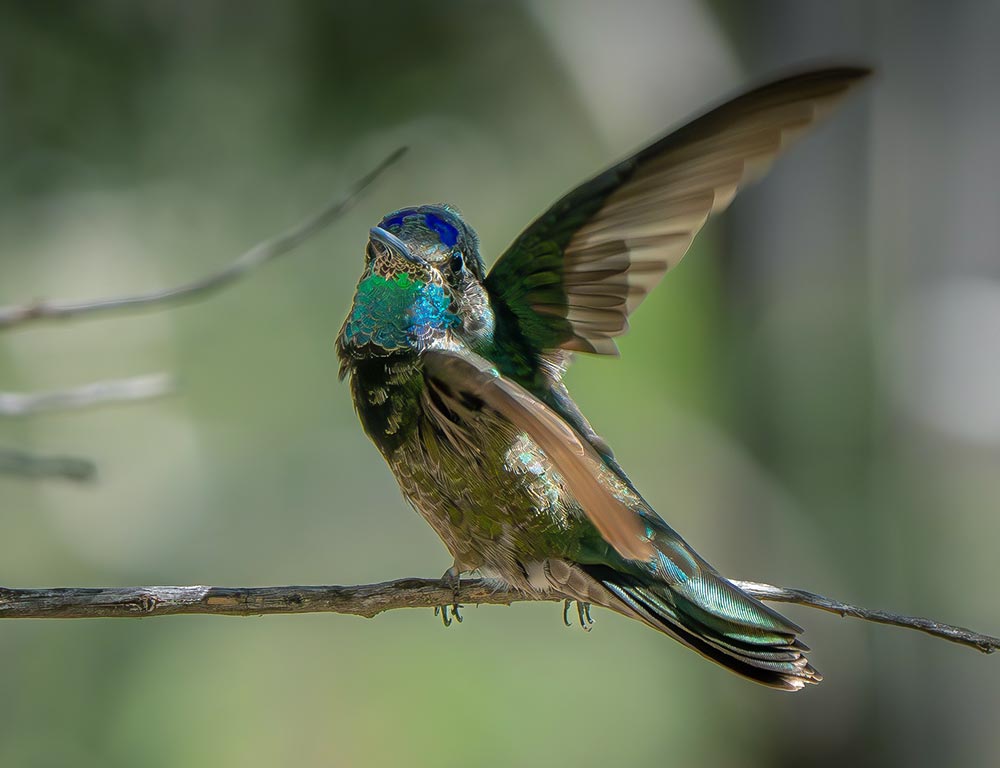
- Scientific name: Eugenes fulgens
- Category: Medium-sized hummingbird
- Population: Resident in western Mexico, occasional sightings in the southwestern United States, including parts of Arizona and New Mexico
- Life span: 3 to 5 years
- Size: 4.3 to 5 inches
- Weight: 8 to 11 grams
- Food: Nectar, insects
- Wingspan: 5.1 inches
- Status: Least Concern (according to the IUCN Red List)
Rivoli’s Hummingbird, also known as the Magnificent Hummingbird, is a medium-sized species with striking iridescent colors. Males have a vibrant green crown and throat, while females have a more subdued green color.
They are mainly found in western Mexico but can occasionally be seen in parts of the southwestern United States.
These hummingbirds feed on nectar from various flowers and also capture insects in flight for additional protein. Rivoli’s Hummingbirds are known for their distinctive vocalizations, which include sharp chips and buzzes.
During the breeding season, males engage in aerial displays, showcasing their brilliant colors and agility to attract females.
The nests of Rivoli’s Hummingbirds are typically constructed on horizontal branches, using plant fibers, moss, and lichens. They contribute to pollination as they move between flowers, aiding in the reproduction of flowering plants.
10. Broad-billed Hummingbird

- Scientific name: Cynanthus latirostris
- Category: Small bird
- Population: Resident in Mexico, southwestern United States, including parts of Arizona and New Mexico
- Life span: 3 to 5 years
- Size: 3.5 to 4 inches
- Weight: 2 to 5 grams
- Food: Nectar, insects
- Wingspan: 4.3 inches
- Status: Least Concern (according to the IUCN Red List)
The Broad-billed Hummingbird is a small but vibrant species with a distinctive broad bill. Males have a dazzling metallic blue throat and a striking green body, while females have a more subdued green color.
They are primarily found in Mexico and the southwestern United States, including parts of Arizona and New Mexico.
Broad-billed Hummingbirds feed on nectar from various flowers, and they also catch insects in flight for additional nutrients.
Their specialized bills allow them to access nectar from tubular flowers. During the breeding season, males engage in aerial displays, showcasing their colorful plumage to attract females.
Females build cup-shaped nests on horizontal branches using plant fibers, downy materials, and spider silk. Broad-billed Hummingbirds play a crucial role in pollination as they visit flowers in search of nectar, contributing to the reproductive success of flowering plants.
11. Mexican Violetear
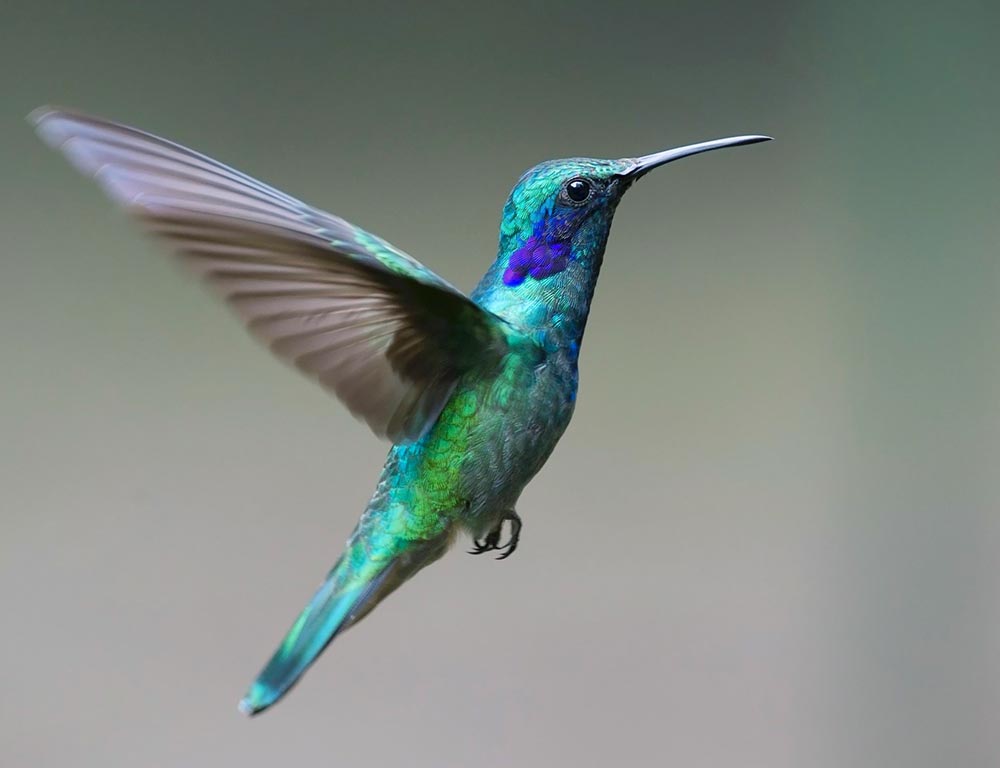
- Scientific name: Colibri thalassinus
- Category: Medium-sized hummingbird
- Population: Resident in Mexico and Central America, occasional sightings in the southwestern United States
- Life span: 3 to 5 years
- Size: 4 to 4.5 inches
- Weight: 7 to 12 grams
- Food: Nectar, insects
- Wingspan: 5 inches
- Status: Least Concern (according to the IUCN Red List)
The Mexican Violetear is a medium-sized hummingbird with a distinctively violet patch on its ear cover.
These hummingbirds are primarily residents of Mexico and Central America, with occasional sightings in the southwestern United States. Mexican Violetears feed on nectar from a variety of flowers, and they also consume insects for protein.
Their iridescent green plumage and unique violet markings make them easily distinguishable. During the breeding season, males engage in courtship displays involving aerial acrobatics and vocalizations.
The nests of Mexican Violetears are constructed on tree branches, using plant fibers and other soft materials.
These hummingbirds contribute to pollination as they visit flowers, transferring pollen and aiding in the reproduction of flowering plants. Their presence adds a touch of vibrancy to the ecosystems they inhabit.
Wrapping Up
In the kaleidoscope of Kansas skies, hummingbirds dance gracefully, contributing to the state’s biodiversity and captivating the hearts of nature enthusiasts.
From the vibrant Ruby-throated to the elusive Rivoli’s, these delicate creatures play a crucial role in pollination, enriching the ecosystems they inhabit. Their aerial displays, unique nesting habits, and migratory journeys reveal a world of wonder.
As guardians of flora and symbols of resilience, Kansas’ hummingbirds offer a profound connection to nature’s intricate tapestry, reminding us of the delicate balance within our ecosystems.
Observing these enchanting birds in Kansas is not merely a visual delight but an opportunity to witness nature’s poetry in flight, a testament to the state’s rich avian tapestry. Best of luck.